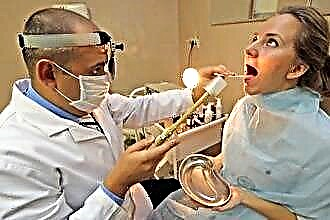The ear of a healthy person contains only sulfur, which performs a protective function in it. However, with certain pathological processes, the presence of purulent or bloody contents may also be noted. The appearance of this sign indicates the development of a pathological process.

Pus is a sticky, viscous, yellowish liquid with a characteristic odor. It must be distinguished from bloody contents. Clarification of the nature of the discharge from the ear helps in the diagnosis of the disease.
The reasons why blood flows from a child's ear are different from conditions accompanied by suppuration. Purulent discharge is always a sign of an inflammatory process in the ear and is caused by the effect of a bacterial pathogen.
Blood in a child's ear indicates a traumatic injury and a violation of the integrity of the skin.
Causes
The appearance of blood from the ear may be due to the development of aerootitis, which is more often observed in divers and military pilots. With the development of hostilities, this symptom can be noted during the propagation of a sound wave from a bomb explosion. A similar mechanism can develop when trying to sneeze with closed nasal openings. In this case, sudden changes in atmospheric pressure lead to rupture of the tympanic membrane and are accompanied by bloody discharge from the ear.
For a child, such a mechanism for the development of this symptom is atypical. Unlike adults, the most common cause of ear bleeding in children is mechanical damage from a sharp object. It is the ingress of a foreign body into the external auditory canal that causes blood to appear from the child's ear. At the age of 2 to 5 years, this symptom is most often observed during children's play. In this regard, any small objects, buttons, bolts, screws are very dangerous toys.
 Another reason why a child is bleeding is due to inaccurate handling of the ear toilet. In most cases, such actions are caused by excessive diligence of parents who want to effectively free the ear from wax. Dangerous sharp objects are used for this, such as pins, matches, pencils, scissors, with cotton wound around them, while even factory-made pharmacy ear sticks are designed exclusively for cleaning the auricle.
Another reason why a child is bleeding is due to inaccurate handling of the ear toilet. In most cases, such actions are caused by excessive diligence of parents who want to effectively free the ear from wax. Dangerous sharp objects are used for this, such as pins, matches, pencils, scissors, with cotton wound around them, while even factory-made pharmacy ear sticks are designed exclusively for cleaning the auricle.
The external auditory canal in infants can be cleaned only with the use of cotton filaments.
The delicate skin of newborns can be injured by any careless action.
Emergency help
If the child bleeds while cleaning the ear, the following steps should be taken:
- Stop the procedure;
- Examine the external auditory canal and try to determine the location of the scratch;
- Press the injury site with a gauze pad to stop bleeding;
- It is recommended to treat the wound surface with an antiseptic solution, ethyl alcohol, alcoholic solution of brilliant green or hydrogen peroxide;
- In order to prevent infection, the external auditory canal should be closed with a cotton swab.
Eardrum injury
In some cases, excessive diligence and inaccurate actions lead to the fact that not only the superficial layer of the skin of the external auditory canal is injured, but also the eardrum.
The first symptom of a ruptured eardrum during ear cleaning is sharp pain.
 As for the development of other signs, their presence depends on the area of the traumatic surface, the depth of the lesion. At the same time, adult patients note a feeling of "draft" in the ear. There is noise and hearing loss from the affected side, blood is noted from the child's ear, the reasons for the appearance of which are due to a violation of the integrity of the skin.
As for the development of other signs, their presence depends on the area of the traumatic surface, the depth of the lesion. At the same time, adult patients note a feeling of "draft" in the ear. There is noise and hearing loss from the affected side, blood is noted from the child's ear, the reasons for the appearance of which are due to a violation of the integrity of the skin.
In the future, two options for the development of this situation are possible. In the event that the hole is insignificant, the patient's condition may improve over time. Acute ear pain will be replaced by noise and congestion. Over time, when the integrity of the tympanic membrane is restored, these symptoms also regress.
However, there is also a more severe development of the disease. In this case, the main role is assigned to the effect of pathogens, which can lead to the development of inflammation of the outer and middle ear. The accession of a secondary infection is evidenced by
- worsening of the condition, which is manifested by persistent noise in the ear;
- ear congestion; hearing loss;
- deterioration in general condition;
- an increase in body temperature to subfebrile or high numbers.
Therapeutic tactics
In all cases, when, while cleaning the ear, the child has pain, spotting and hearing loss, the patient should be examined by an otolaryngologist.
 Using instrumental diagnostics, a specialist should determine the condition of the tympanic membrane. In the absence of perforation, ear drops are prescribed, which have an antiseptic, anti-inflammatory effect. In this case, it can be Sofradex, Otipax, Otinum. In the presence of perforation of the tympanic membrane, these funds cannot be used, due to the presence of ototoxic components in their composition.
Using instrumental diagnostics, a specialist should determine the condition of the tympanic membrane. In the absence of perforation, ear drops are prescribed, which have an antiseptic, anti-inflammatory effect. In this case, it can be Sofradex, Otipax, Otinum. In the presence of perforation of the tympanic membrane, these funds cannot be used, due to the presence of ototoxic components in their composition.
At the same time, in the presence of an injured eardrum, the appointment of ear drops containing antibiotics, Tsipromed, Normax, Otofa is indicated. In addition, drugs and physiotherapy procedures are shown to help restore the integrity of the tympanic membrane. In cases where, despite the conducted conservative treatment, there is still a sufficient hole in it, the question of surgical intervention to restore its integrity and conduct reconstruction may be raised.
In order for the disease to have a more favorable course, a patient with a mechanical injury to the tympanic membrane should be immediately examined by a specialist. At the same time, all his instructions must be clearly followed.



